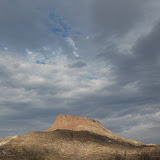
This screen shot - taken this morning - illustrates about how cold it ever gets in SA. I've ridden more than a few times in weather like this. Sometimes it's fun. Often it's not.
I was talking to a friend that rode a motorcycle as his only means of transportation for about ten years. It wasn't until he started dating (his now-wife) that he discovered the wonders of automotive transportation. She made him ride in her car when the weather turned really ugly. He discovered that he was burned out from riding after all that time.
I can see why. After cracking my tibia from a motorcycle accident almost two years ago (and finally able to run again!), I was forced to drive to work. I discovered that it really wasn't so bad. Yeah, I had blind spots again. I couldn't stretch out like I wanted. But I could listen to the radio when I wanted to. I could turn the air or heat on. I felt less threatened on the highway. People saw me at intersections. I didn't have to buy expensive gear just to commute. I didn't have to replace my tires once or twice a year. I could bring long and large items with me. I could just "jump in" and go.
Yeah it's easier on gas. It's (often) cheaper on insurance; Insurance companies view motorcycles as "recreational vehicles." It makes sense. They're not ideal in many weather conditions. And the FJR is only nominally better on gas than my wife's 30+ mpg car. Like the way her car is marginally better than my 18-22 mpg truck. Is commuting by motorcycle really cheaper? Perhaps not.
So my friend had a piece of advice: "Put the bike away and ride when you feel like it. That way you don't get burned out." Maybe it comes from getting older or not wanting to ride when it's cold out. Perhaps I'm discovering that I'm married to my wife, not the motorcycle. Either way, I'm going to ride less and enjoy it more. Let's see if that works!


